Moving into a failed restaurant space has its advantages — and its pitfalls.
There are two big considerations when opening a new restaurant: time and money. Thinking of these, many operators open new venues in spaces formerly occupied by other restaurants in a bid to save on both. However, beware: Sometimes previously occupied spaces take more money and time than moving into a newly empty space.
Take a look at several restaurant operations across the country to see how they reclaimed a former restaurant spot for themselves, why they did so and what the process involved.
Reuse, Repurpose, Recycle
When Famous Toastery got its start in 2005, it did so thanks to the failure of a breakfast and brunch spot in Huntersville, N.C. Since then, it’s opened another 13 restaurants, 7 of which occupy spaces claimed from failed ventures.
“It’s much cheaper in the beginning to do this,” says Robert Maynard, co-founder and CEO of the Davidson, N.C.-based full-service breakfast, brunch and lunch chain. “In fact, our three or four most popular restaurants were all in failed restaurant spaces.”
But it’s not always cheaper. A former Atlanta Bread Company location in Columbia, S.C., which will open next spring as a Famous Toastery, had little that could be reused or repurposed, which meant that on top of building a new restaurant, there was the significant cost of demolition, too.
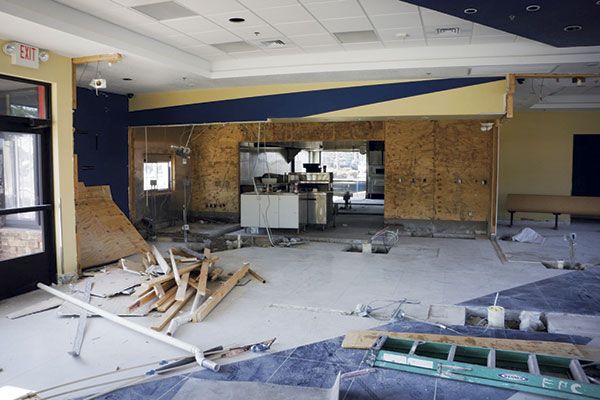 Famous Toastery makes a habit of reclaiming failed restaurant spaces. The team ofen encounters this kind of scene at the start of a new project. Photo courtesy of Famous ToasteryMaynard examines each location carefully before committing to it, from the parking and ADA accessibility to building composition as well as interior and exterior aesthetics. He also looks at the restaurant infrastructure — plumbing, drains, HVAC, hood systems and dishwashing. “After that, we look at floor plan layout usability, how it flows from the shape of the building, the size, the doors and grills,” he says. “We look at what we can use without sacrificing our design standards.”
Famous Toastery makes a habit of reclaiming failed restaurant spaces. The team ofen encounters this kind of scene at the start of a new project. Photo courtesy of Famous ToasteryMaynard examines each location carefully before committing to it, from the parking and ADA accessibility to building composition as well as interior and exterior aesthetics. He also looks at the restaurant infrastructure — plumbing, drains, HVAC, hood systems and dishwashing. “After that, we look at floor plan layout usability, how it flows from the shape of the building, the size, the doors and grills,” he says. “We look at what we can use without sacrificing our design standards.”
Most frequently, Famous Toastery finds it can use the mechanical and plumbing infrastructure from previous restaurant tenants. Hood systems can also often be reused or supplemented. “It’s a lot of little things; there’s usually not one big factor,” says Jim Largay, owner of JWL Management in Lodi, Wis., who has worked with Famous Toastery on 11 of its 14 locations.
In May 2014, Famous Toastery converted a former PDQ, a chicken quick-serve restaurant in Tega, S.C. Eighty-five percent of the kitchen was reused — including the floor, walk-in cooler and water heater — as were the mechanical systems. All in, says Largay, “we saved about 40 percent on our prototypical budget.”
That’s more than usual, but the savings are there on many of these restaurant reclamations, Maynard says. “A typical restaurant costs $600,000 to build out and open, and we have saved anywhere from $100,000 to $400,000 when we’ve reclaimed.”
There are some former restaurants that wouldn’t make sense for the chain to reclaim, particularly if they’re older, in disrepair or if the infrastructure is unusable, Largay says. Sometimes, however, Maynard can negotiate leases with landlords due to these shortcomings and make it work.
When Founding Farmers announced the location of its latest restaurant, which opened in February 2015 in Tysons, Va., people wondered what the chain was thinking. But it was the building the
company wanted — a modern Virginia farmhouse — and management was convinced they could make the location work.
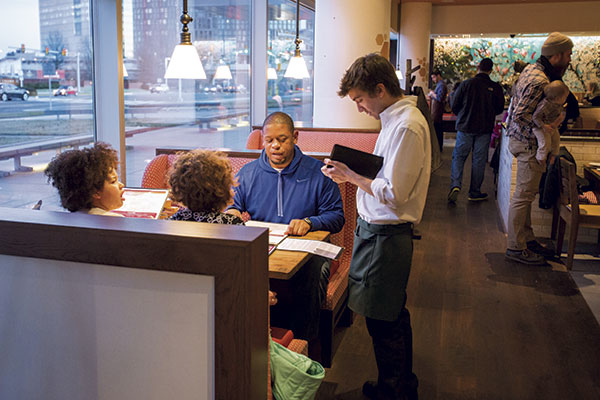 Before taking over a twice-failed site, the Founding Farmers team assessed why the previous efforts failed. They ended up with a popular restaurant in Tysons, Va. Photo by Ken Fletcher“People said we were crazy — we’re on the backside of an office building, the entrance is strange and two restaurants have failed there,” says Dan Simons, one of the owners of the Kensington, Md.-based chain.
Before taking over a twice-failed site, the Founding Farmers team assessed why the previous efforts failed. They ended up with a popular restaurant in Tysons, Va. Photo by Ken Fletcher“People said we were crazy — we’re on the backside of an office building, the entrance is strange and two restaurants have failed there,” says Dan Simons, one of the owners of the Kensington, Md.-based chain.
However, not wanting to succumb to the same fate as the two previous restaurants, Simons came up with a hypothesis of why they failed. “Based on that, I decided what our concept was going to be and how we were going to operate,” he says. “I certainly wouldn’t want to go into a space and do the same thing the last people did.”
He was fairly confident. The previous restaurant was fine dining and too big to properly manage, especially for a first-time restaurateur. Simons and his team, by contrast, had three restaurants under their belts. “We had the experience and the operational talent to operate a restaurant,” he explains. “And we’ve been doing it for quite a long time. Plus, I know our brand is very approachable with price, so we’re serving a broader audience.”
There were also inherent issues with the restaurant, Simons says. “It was laid out in a way that wasn’t designed for efficiency, didn’t have enjoyable sightlines for the guests; the layout was confusing, and there were lots of walls. So we blew the whole thing up and opened it up and made it more accessible.”
In the back of the house, Simons retained plenty: the storage areas, the walk-ins, the hoods, the refrigeration and the prep equipment, as well as the HVAC and mechanicals. He donated, sold, auctioned or recycled most front-of-house items, though he did move a few chairs to the back offices. All in all, he says, utilizing a reclaimed space saved the company around $300,000.
You’re in a good negotiating spot when you take over a failed restaurant, Simons says, since landlords are typically eager not to have their next tenant fail. “I told the landlord one of the reasons the previous restaurant failed was his rent was too high.” Through negotiating, Simons was able to save, he says, “in the categories of base rent, tenant improvement dollars and free rent.” Other negotiable items include the right to have all the existing contents of the space at no cost, either to use or to sell to generate cash.
Often, Simons explains, “the second or third time around, landlords want to do things to set the tenant up for success because they think with two or three failures in a space, no one will go in there again.”
Reclaiming a restaurant doesn’t come without downsides, Simons says. You have to acquaint yourself with where everything is — drains, electrical points and so forth — and figure out whether you can use them. All of this takes time.
You also have to test any existing equipment and HVAC systems, he says, and you won’t know how those work until you get into the space. “There’s a lot of digging and exploring to see how good it is and how well it was done. Maintenance costs can be very expensive and sometimes more so than demoing a location and doing it from scratch.”
Reclaiming a restaurant doesn’t save any time for Founding Farmers, Simons points out. With a reclaimed space, “it is more detail-intensive to coordinate what gets saved and integrated into a new design than to just start from scratch, so while it might save time in building, it adds time in coordinating and integrating the old into the new.”
The Almost Total Demolition
5Church opened last November in a space that formerly housed a dive bar in Charleston, S.C.
It was the historical building that appealed to owner Patrick Whalen. “The bones of the space are spectacular,” he says. “It’s a 100-year-old mariner’s chapel with 40-foot ceilings.”
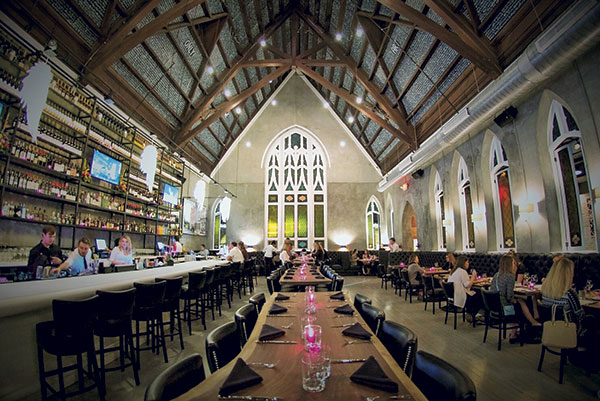 5Church did a gut rehab of a 100-year-old building that had most recently housed a dive bar. The rehab restored the grandeur of what was once a mariners chapel. Photo courtesy of 5Church CharlestonAnd the bones were all he needed. He gutted the entire building, minus the infrastructure, the front door, kitchen floor tiles and a walk-in.
5Church did a gut rehab of a 100-year-old building that had most recently housed a dive bar. The rehab restored the grandeur of what was once a mariners chapel. Photo courtesy of 5Church CharlestonAnd the bones were all he needed. He gutted the entire building, minus the infrastructure, the front door, kitchen floor tiles and a walk-in.
A lot of the electrical infrastructure had to be changed or moved, and plumbing had to be augmented, Whalen explains. He gutted and rebuilt the bar, though some of the plumbing was retained. Bathrooms were gutted and removed as they were not up to code, and he replaced the kitchen equipment.
The downside of a project like this is it takes longer — about four months longer than anticipated. It also costs more, though given its success once opened, Whalen says he’d have paid double for it.
“Good bones” also attracted Chef Kevin Gillespie to a historical farmhouse in the city of Decatur, Ga., that would become Southern food outpost Revival.
Nothing from the former restaurant, a pub with fresh seafood, was of any use to Gillespie, who kept only windows, hardwood floors and plaster. “We were breaking all the cardinal rules of frugality, but we felt it was worth the risk for that building.”
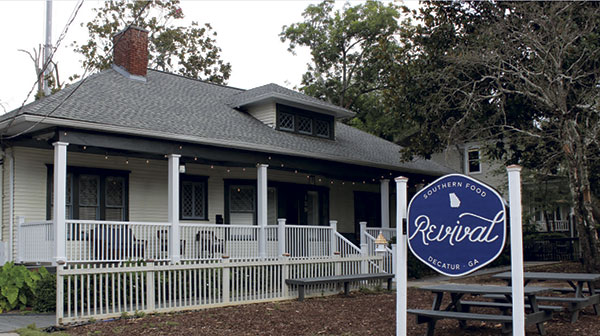 Located in a rehabbed farmhouse that was once a pub, Revival is now a popular Southern food outpost. Photo courtesy of RevivalBecause of this, the biggest problem he faced was cost, which included buying out the former tenant, knowing everything left behind was unsalvageable. All told, this restaurant cost 50 percent more than the previous restaurant Gillespie had opened, which had required a build-out from scratch.
Located in a rehabbed farmhouse that was once a pub, Revival is now a popular Southern food outpost. Photo courtesy of RevivalBecause of this, the biggest problem he faced was cost, which included buying out the former tenant, knowing everything left behind was unsalvageable. All told, this restaurant cost 50 percent more than the previous restaurant Gillespie had opened, which had required a build-out from scratch.
The secondary challenge, he says, involved the things they didn’t — and couldn’t — know. “There were upgrades the previous tenants had not done properly, and we were fixing things we didn’t think we’d have to fix,” says Gillespie. Fixes included adding structural support to floors and moving electrical panels.
Gillespie opened Revival in July 2015 after seven months of work — in contrast, he says, “to five months for our previous restaurant that was built from a first-generation spot.” But he has no regrets. “If we had built in a different location, the restaurant would not have the same character and charm. Both of these attributes are critical to our success.”
A Salvage Job
Six years ago, Richard DeShantz opened his casual-dining restaurant, Meat & Potatoes, in a space in Pittsburgh that had formerly housed a fine-dining Portuguese concept.
Now, as he prepares to open his fourth restaurant in Pittsburgh, Old Country Buffet, in a space that formerly housed an American eatery, he realizes he’s learned a lot since that first venture.
 At Meat & Potatoes, restaurateur Richard DeShantz kept the infrastructure, repurposed the bar and even painted existing light fixtures. Photo by Adam Milliron“Most of my restaurants are in failed restaurant spaces,” says DeShantz, chef and owner of his eponymous restaurant group, which is also based in Pittsburgh.
At Meat & Potatoes, restaurateur Richard DeShantz kept the infrastructure, repurposed the bar and even painted existing light fixtures. Photo by Adam Milliron“Most of my restaurants are in failed restaurant spaces,” says DeShantz, chef and owner of his eponymous restaurant group, which is also based in Pittsburgh.
With Meat & Potatoes, the foundation was all there, he says: the plumbing, bathrooms, electrical, HVAC system and sprinklers, so he kept all that as well as some of the furniture.
The fundamentals are what increase the costs on a restaurant build, DeShantz says. “It’s not the bar top or the wallpaper; it’s the internal things.” As for the furniture, he tries to use as much as he can.
At Meat & Potatoes, he repurposed the bar and painted some of the existing lighting. He also reupholstered and painted the chairs. “I wanted a hodgepodge so everywhere you look, there’s something funky.”
Replacing Like with Like
In the first quarter of this year, Ovation Brands, parent company of Old Country Buffet and other buffets, filed for bankruptcy and closed more than 160 restaurants, opening up the market to the company’s main competitor, Golden Corral.
Based in Raleigh, N.C., Golden Corral had 480 locations at the time and realized this was an exciting opportunity for growth. By the end of this year, the chain expects to have 15 more locations open across the country in restaurants reclaimed from its competitor.
“What makes these a good fit is these were buffet restaurants, so the interior flow that worked for them will certainly work for us, and there aren’t a lot of changes,” says Bob McDevitt, senior vice president of franchise development. “For the most part, we can move in, reuse equipment and change it to our concepts.”
Most of the changes Golden Corral makes are cosmetic, McDevitt says. “Most of it is adding our trade dress — our colors, our sign package, the particular sneeze guard we like to use — to keep our chain consistent.”
But the process is lengthy as there are negotiations with landlords and permitting processes. However, it takes only half of the time that it would to open a buffet restaurant in a building that had not previously contained a buffet, McDevitt says. And the real advantage for Golden Corral is that it also costs about half as much.
Lumberjacks, a franchise chain of full-service log cabin-themed diners, has opened all of its restaurants in reclaimed spaces.
There are two main advantages to this, says Jeff Garrett, the Redding, Calif.-based chain’s founder: Build-out costs are significantly lower, and the footprints are usually ideal for
conversion.
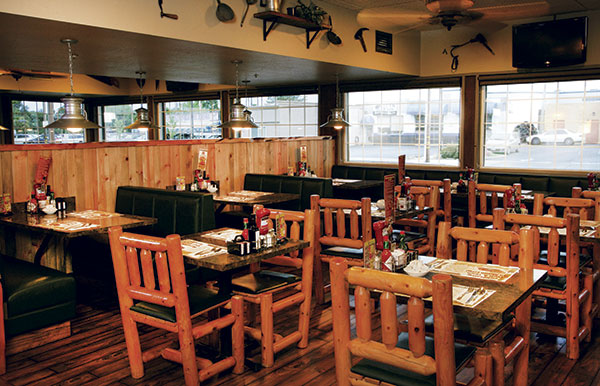 Log-cabin-themed chain Lumberjacks always uses failed restaurant spaces because they have found that build-out costs are significantly lowered. Photos courtesy of LumberjacksIt helps, of course, that Garrett typically looks for restaurants with a similar positioning to Lumberjacks, and he usually only makes cosmetic changes to the locations. “It’s about making the restaurant look fresh, new and in our style,” he says. He rips everything out but keeps the same layout and flow, adding proprietary tables, chairs, booths and colors.
Log-cabin-themed chain Lumberjacks always uses failed restaurant spaces because they have found that build-out costs are significantly lowered. Photos courtesy of LumberjacksIt helps, of course, that Garrett typically looks for restaurants with a similar positioning to Lumberjacks, and he usually only makes cosmetic changes to the locations. “It’s about making the restaurant look fresh, new and in our style,” he says. He rips everything out but keeps the same layout and flow, adding proprietary tables, chairs, booths and colors.
Garrett alters kitchens as little as possible, though they usually need new equipment, and bathrooms are usually kept but are redesigned and updated to meet ADA standards as required.
If Lumberjacks went into a space that had never housed a restaurant, it would cost around 30 percent more, Garrett says. It’s also significantly faster for the chain to reclaim a restaurant. His remodels take 25 to 30 days, which is a short enough time span for some people to be surprised when they drive by and see a new dining spot. However, he points out, “if you build from the ground up, people get more excited as they see it being built.”
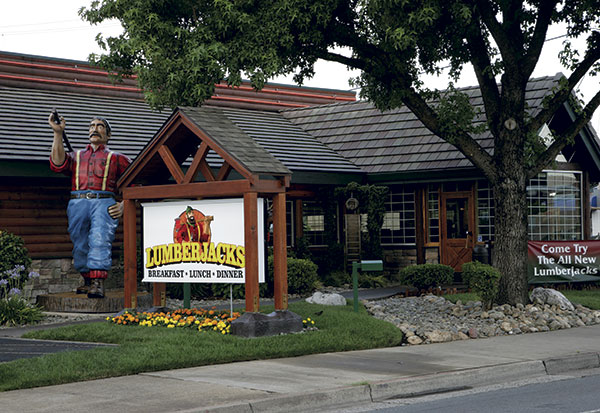 If you open up quickly enough, sometimes the old customers just keep coming, so there’s a built-in business. Conversely, if you build from the ground up, you’re starting from scratch and often don’t even have an opening date because you don’t know how long your build-out will take.
If you open up quickly enough, sometimes the old customers just keep coming, so there’s a built-in business. Conversely, if you build from the ground up, you’re starting from scratch and often don’t even have an opening date because you don’t know how long your build-out will take.
Time and cost vary so dramatically from one reclaimed restaurant to another that any operator considering this option needs to do plenty of homework.

